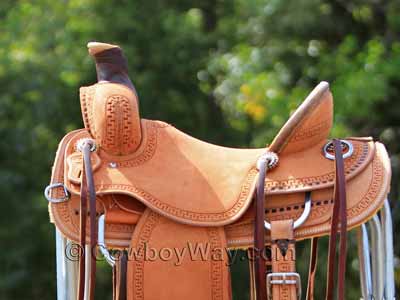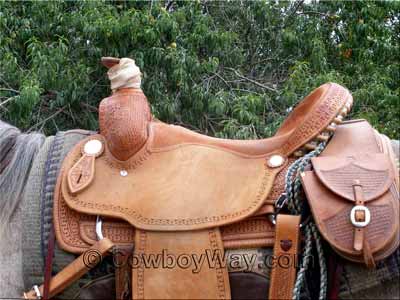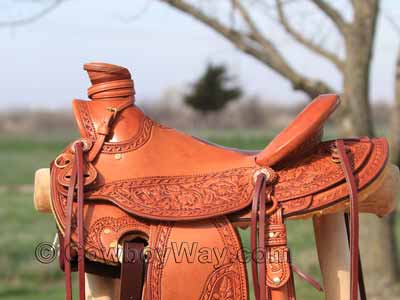Legendary Billy Cook saddlery is known for making quality, rugged, ranch saddles that last a lifetime.
Billy Cook ranch saddles are prized for their their cowboy-tough construction, comfort, and great looks. They come in several different models that are all designed for hard work day after day.
Below: A Billy Cook ranch saddle from HorseSaddleShop.
Comparison Shop For Billy Cook Ranch Saddles
Below are Billy Cook ranch saddles for sale from eBay and HorseSaddleShop. This page makes it easy to compare selection and prices between these major online sellers.
NOTE: Some eBay sellers will use the words “Billy Cook” somewhere in a saddle’s description, which will cause it to show up below even though the saddle is made by a different saddle maker. Read the saddle’s description carefully to find out if it is actually made by Billy Cook.
From eBay and HorseSaddleShop
See more Billy Cook ranch saddles On HorseSaddleShop
See more Billy Cook ranch saddles On eBay
Read The Billy Cook Ranch Saddle Reviews
Most of the Billy Cook saddles on HorseSaddleShop, above, have reviews left for them by other people who have either purchased that saddle, and/or done business with HorseSaddleShop. To see the reviews, click on any saddle you’re interested in above, then look for the reviews near the saddles’s description.
Is A Ranch Saddle The Same As A Roping Saddle?
No, it isn’t. Well, it might be. It just depends on who you ask.
Ranch saddles and roping saddles are both made to handle the force and stress of roping cattle. After that, everything is simply a matter of personal preference.
Since there is not an industry-wide standard for the terms “ranch saddle” or “roping saddle,” individual saddle makers make their own distinctions as to what each of these types of saddle should be. On top of that, individual riders have their own opinions about the saddles they use. What one of them considers to be a ranch saddle might be a saddle someone else feels is more accurately described as a roping saddle.
Even so, there are at least a couple of general distinctions between the two types of saddles. Perhaps the biggest distinction between a ranch saddle and a roping saddle is the use the saddle is designed for:
- The phrase “ranch saddle” is usually assigned to a saddle made to ride for long hours in rough country. A ranch saddle is also made for roping cattle of all sizes, from small calves to large adult cows, steers, or bulls.
- On the other hand, the phrase “roping saddle” typically means a saddle designed for fast roping in an arena (for example, team roping, tie-down roping, or breakaway roping). A roping saddle is also designed to rope cattle of all sizes.
So, what does this mean in terms of design? For just a couple of examples:
- Ranch saddles typically have a deeper seat and a higher cantle than roping saddles. These attributes are a favorite among working cowboys and cowgirls for their comfort during long hours in the saddle, and a secure seat when riding in rough country.
- Roping saddles, on the other hand, often have flatter seats and lower cantles than ranch saddles. This allows for faster freedom of movement, such as when a roper breaks from behind a barrier and shifts much of their weight and balance to their feet. Ranch saddles certainly allow the same movements, but lower cantles and flatter seats can make these movements faster for riders being competitively timed to within fractions of a second.
Below: A ranch saddle with a deep seat and a high cantle.

Below: A roping saddle with a flatter seat and a slightly lower, more slanted cantle than compared to the saddle above. Although this saddle was described by its maker as a roping saddle, its owner used it as a ranch saddle.

And then, there are saddle horns. Ranch saddles and roping saddles both have saddle horns that are thicker and sturdier than horns typically found on other types of saddles. This, of course, is to help the saddle handle the pull and weight of roping cattle. After that, though, there can be differences.
- Ranch saddle horns are often – but not always – thicker than roping saddle horns, and sometimes have a lower profile to allow freedom of movement for your rein hand. These saddle horns are designed to help the roper to easily work their dallies (holding or sliding) while a critter is held for a little while, such as when it’s being doctored or for some other purpose.
- Roping saddles frequently have saddle horns that are straighter (and sometimes taller), allowing for faster dallying and un-dallying, like in team roping.
Below: A ranch saddle. Notice it has a shorter, thicker saddle horn than either of the saddles above.

As we said earlier, there isn’t an industry-wide standard for the differences between a ranch saddle (by Billy Cook or any other brand) and a roping saddle. The differences we mentioned on this page are not only not definite, there are more possible distinctions than we mentioned.
The choice is up to the saddle maker as to how they design, build, or describe a saddle. It’s also your choice, the buyer/rider, as to what you prefer to ride and use.
You might also like: